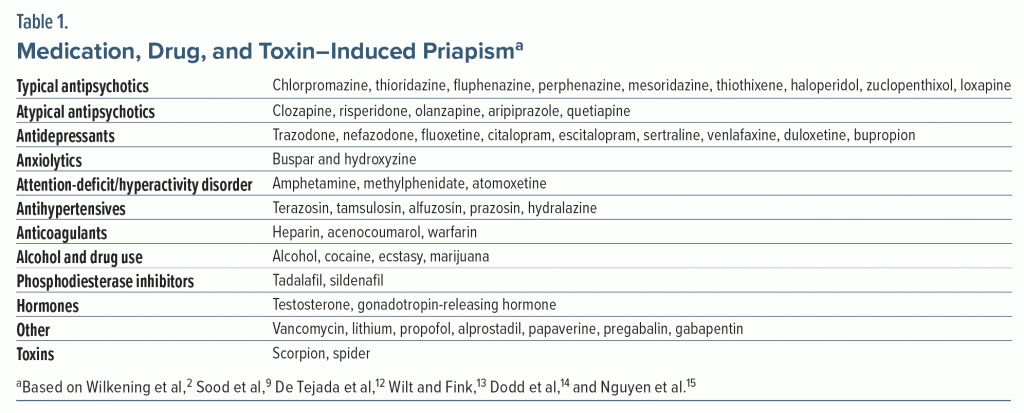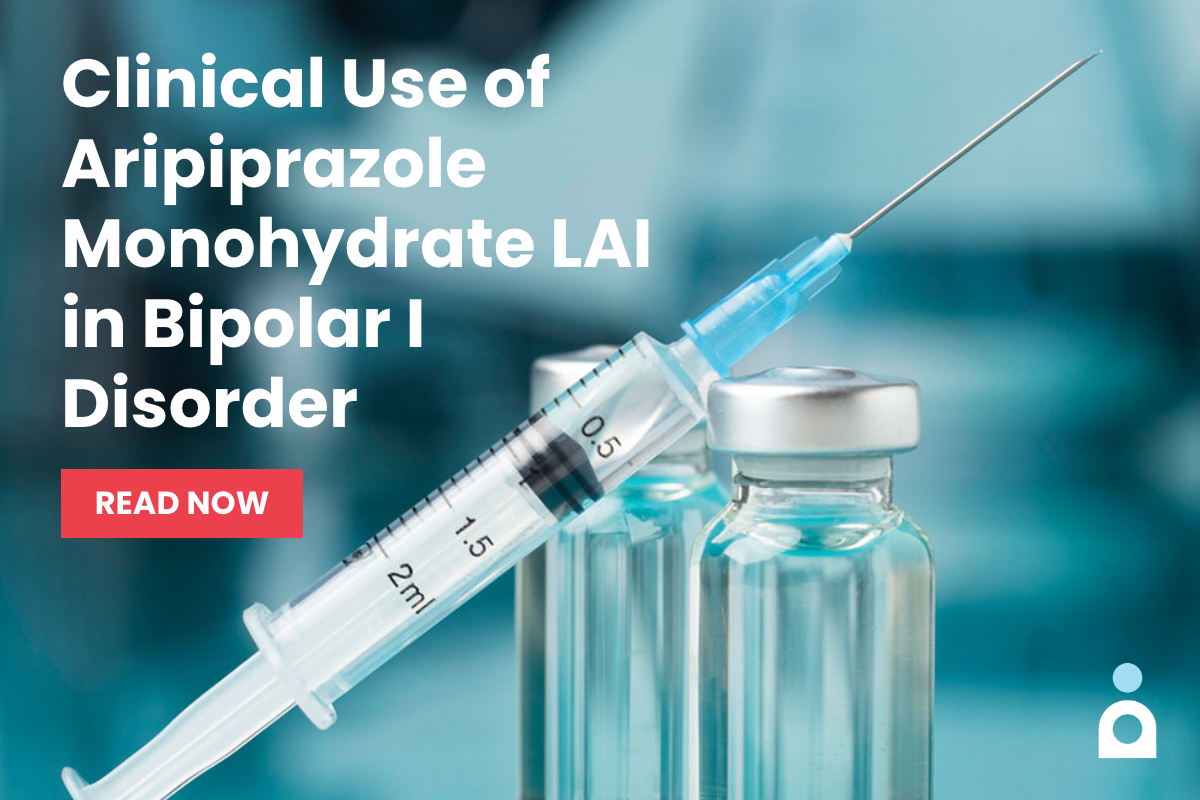Priapism is a persistent or painful penile or clitoral erection lasting at least 4 hours unrelated to a sexual trigger or desire.1 There are 0.9 cases of priapism reported per 100,000 person-years in the US.1 The most common etiologies are sickle cell disease, malignancy, leukemia, or trauma. Pharmacologic agents cause about one-third of new cases of priapism. These agents include α-adrenergic receptor antagonists, antipsychotics, antidepressants, anticoagulants, antihypertensives, hormones, and recreational drugs like cocaine, ecstasy, alcohol, and cannabis.1–3 Psychotropics cause over 50% of medication-induced priapism.4,5
Priapism is a medical emergency that can cause permanent erectile dysfunction, fibrosis, disfigurement, and impotence.1,6 Priapism can be of ischemic (low flow) or nonischemic (high flow) origin or stuttering (intermittent) characterized by painful erections with periods of detumescence.6 Both adrenergic and serotonergic systems are involved in the pathogenesis of priapism. The erection process is typically triggered by the α1-adrenergic blockade, with the activation of the α2-adrenergic receptor exacerbating the α1-adrenergic-mediated priapism through the release of a nitric oxide–like substance, which is a potent muscle relaxant causing painful prolonged erection.5,7–9 Conversely, penile erection is caused by the stimulation of the serotonin system through 5-hydroxytryptamine (5-HT)–1b and 1c/1d receptors. In contrast, penile relaxation is caused by stimulation of the 5-HT1a or 5-HT2 receptor.2
The stimulants and atomoxetine carry US Food and Drug Administration package insert warnings for priapism.1,5 Attention-deficit/hyperactivity disorder (ADHD) stimulant medications like methylphenidate and amphetamine can cause priapism because of dopamine release and/or α-adrenergic activity.1,5 Atomoxetine, a norepinephrine selective reuptake inhibitor and α2-adrenergic agonist,3 can cause priapism. Viloxazine, a recently approved nonstimulant ADHD medication for pediatric and adult ADHD patients,10 is also a selective norepinephrine reuptake inhibitor and a serotonin system activator. We report, to our knowledge, the first case of partial penile priapism with a 300-mg dose of viloxazine in a 10-year-old child.
Case Report
A 10-year-old White boy, Tanner stage 2, with ADHD was started on viloxazine because of previous psychostimulant intolerance due to mood swings, irritability, and insomnia. We optimized viloxazine over 4 weeks to 300 mg/d. The patient showed clinical improvement in ADHD symptoms over a month, with no reported side effects. He was taking no other psychotropic medication. His baseline laboratory values were within normal range. About 8 weeks into the treatment, the patient started experiencing repeated episodes of a painless erection lasting between a few to 30 minutes in the early morning, which was unusual for him. No discoloration, numbness, or dysuria was reported on examination. There was no recent history of trauma, sexual stimulation, or ingestion of additional prescribed medications or illegal drugs.
Viloxazine was stopped. All relevant investigations were within normal limits, including complete blood count, liver function, renal function, a basic metabolic profile, C-reactive protein, and hyper-coagulation profile. Pelvic ultrasound and penile Doppler tests were normal. Penile erections improved immediately after discontinuing viloxazine. The patient and family requested to resume viloxazine, which was restarted at a smaller dose, then titrated to 150 mg. He continued to be stable on 150 mg/d, as the smaller dose of the medication was safe but still effective. No behavioral or physical side effects were reported after 3 and 6 months of treatment.
Discussion
In our case, the Naranjo probability score was 6.11 Although priapism is a medical emergency that can occur in any age group, the exact etiology is still unclear and possibly multifactorial.7 The drug-induced priapism underlying mechanism involves mainly the α-adrenergic blockade effect. Furthermore, it is partially triggered by serotonin-norepinephrine system modulation.2 Viloxazine, as in our case, has a multimodal mechanism of action at the norepinephrine transporter-adrenergic and serotonin receptors systems.8 Serotonin and norepinephrine reuptake inhibitors like duloxetine or venlafaxine can induce priapism through interaction with these pathways.2,9
Based on previous reports,7,8 a priapism side effect could be an idiosyncratic drug reaction, since it can happen irrespective of the dose, medication onset, duration of the medication, and concomitant use of a drug or medication like a phosphodiesterase-5 inhibitor (sildenafil), antihypertensive, or amphetamine stimulant.7–9 In our patient, the priapism did not happen immediately at the 300-mg dose level and did not recur after discontinuing or rechallenging the medication at a lower dose. At the 6-month follow-up, the patient had no side effects or complications. Cases of priapism with other ADHD medications like amphetamines, methylphenidate, and atomoxetine have been reported.1,3,5 Our patient had not reported a similar reaction with previous ADHD stimulant medications in the past, although they are well-known triggers of priapism.1 De Tejada et al,12 in their crossover study of the effect of trazodone versus trimipramine versus placebo (N = 6) on the nocturnal penile activity recorded by penile gauge during standard polysomnography, found that trazodone on day 4 doubled the non–rapid eye movement (NREM) penile activity compared to trimipramine or placebo (trazodone vs trimipramine vs penile activity = 255 min vs 177 min vs 158 min). Also, priapism has been seen with various psychotropics like antipsychotics, anxiolytics, antidepressant category medication, or lithium, possibly because of their α-adrenergic blocking effect and/or neurotransmitter modulation properties (see list of medication-induced priapism in Table 1).2,7,12–14
Clitoral priapism is a rarely reported side effect with citalopram, bupropion, trazadone, duloxetine, pregabalin, and olanzapine in female patients.15–18 Clitoral priapism has not been documented with ADHD medication. Medication-induced priapism is usually preceded by warning signs of multiple, prolonged, painless erections that are not triggered by sexual activities or desire.9 These early warning signs require a prompt medication change.9 Counseling the patient about these potential side effects and proper monitoring is crucial in early recognition and prevention.9 Since viloxazine is approved for use in children,10 patients and their families should be aware and educated about these serious side effects, and specific sexual side effects should be closely monitored and promptly treated.9 Withholding the medication with proper hydration, exercise, and an ice bag is usually an appropriate initial measure for mild cases. However, emergency urologic intervention is essential in severe cases.9,14
Article Information
Published Online: August 22, 2023. https://doi.org/10.4088/PCC.22cr03458
© 2023 Physicians Postgraduate Press, Inc.
Prim Care Companion CNS Disord 2023;25(4):22cr03458
Submitted: November 7, 2022; accepted February 1, 2023.
To Cite: Al Jumaili W, Mian N, Jain S. Viloxazine-associated partial priapism in children. Prim Care Companion CNS Disord. 2023;25(4):22cr03458.
Author Affiliations: Texas Tech University Health Science Center at Permian Basin, Odessa (Al Jumaili, Jain); Puget Sound Psychiatric Center Bothell, Washington (Mian).
Corresponding Author: Wisam Al Jumaili, MD, 2301 W Michigan Ave Midland, TX 79707 ([email protected]).
Relevant Financial Relationships: None.
Funding/Support: None.
Patient Consent: The patient and his family consented for case publication, and patient anonymity was protected.
References (18)

- Eiland LS, Bell EA, Erramouspe J. Priapism associated with the use of stimulant medications and atomoxetine for attention-deficit/hyperactivity disorder in children. Ann Pharmacother. 2014;48(10):1350–1355. PubMed CrossRef
- Wilkening GL, Kucherer SA, Douaihy AB. Priapism and renal colic in a patient treated with duloxetine. Ment Health Clin. 2016;6(4):197–200. PubMed CrossRef
- Gamo NJ, Wang M, Arnsten AF. Methylphenidate and atomoxetine enhance prefrontal function through α2-adrenergic and dopamine D1 receptors. J Am Acad Child Adolesc Psychiatry. 2010;49(10):1011–1023. PubMed CrossRef
- Doufik J, Otheman Y, Khalili L, et al. Antipsychotic-induced priapism and management challenges: a case report. Encephale. 2014;40(6):518–521. PubMed CrossRef
- US Food and Drug Administration. FDA drug safety communication: FDA warns of rare risk of long-lasting erections in males taking methylphenidate ADHD medications and has approved label changes. FDA website. Accessed July 25, 2023. https://www.fda.gov/drugs/drug-safety-and-availability/fda-drug-safety-communication-fda-warns-rare-risk-long-lasting-erections-males-taking
- Mann RA, George AK. Recurrent priapism in a military veteran receiving treatment for PTSD. Mil Med. 2017;182(11):e2104–e2107. PubMed CrossRef
- Aabbassi B, Benali A, Asri F. Risperidone-induced priapism in an autistic child: a case report. J Med Case Reports. 2016;10(1):164. PubMed CrossRef
- Faison SL, Fry N, Adewole T, et al. Pharmacokinetics of coadministered viloxazine extended-release (SPN-812) and lisdexamfetamine in healthy adults. J Clin Psychopharmacol. 2021;41(2):155–162. PubMed CrossRef
- Sood S, James W, Bailon MJ. Priapism associated with atypical antipsychotic medications: a review. Int Clin Psychopharmacol. 2008;23(1):9–17. PubMed CrossRef
- QELBREE Package Insert. Accessed July 25, 2023. https://www.accessdata.fda.gov/drugsatfda_docs/label/2021/211964s000lbl.pdf
- Liver Tox: Clinical and Research Information on Drug-Induced Liver Injury. Bethesda, MD: National Institute of Diabetes and Digestive and Kidney Diseases. Adverse Drug Reaction Probability Scale (Naranjo) in Drug Induced Liver Injury. NIH website. Accessed July 25, 2023. https://www.ncbi.nlm.nih.gov/books/NBK548069/
- De Tejada IS, Ware JC, Blanco R, et al. Pathophysiology of prolonged penile erection associated with trazodone use. J Urol. 1991;145(1):60–64. PubMed CrossRef
- Wilt TJ, Fink HA. Is antidepressant plus sildenafil a recipe for priapism? Postgrad Med. 2004;116(6):11–12. PubMed CrossRef
- Dodd AL, Patel S, Fipps DC. Loxapine-induced priapism: a case report and review of the literature on antipsychotic-induced priapism: case rep. Psychiatry J. 2021:5589967. CrossRef
- Nguyen J, Chin JJ, Blalock M. Probable drug-induced clitoral priapism due to potentiating effects of pregabalin and duloxetine. Am J Health Syst Pharm. 2023;80(1):e14–e17. PubMed CrossRef
- Bucur M, Mahmood T. Olanzapine-induced clitoral priapism. J Clin Psychopharmacol. 2004;24(5):572–573. PubMed CrossRef
- Pescatori ES, Engelman JC, Davis G, et al. Priapism of the clitoris: a case report following trazodone use. J Urol. 1993;149(6):1557–1559. PubMed CrossRef
- Levenson JL. Priapism associated with bupropion treatment. Am J Psychiatry. 1995;152(5):813a. PubMed CrossRef
Please sign in or purchase this PDF for $40.


